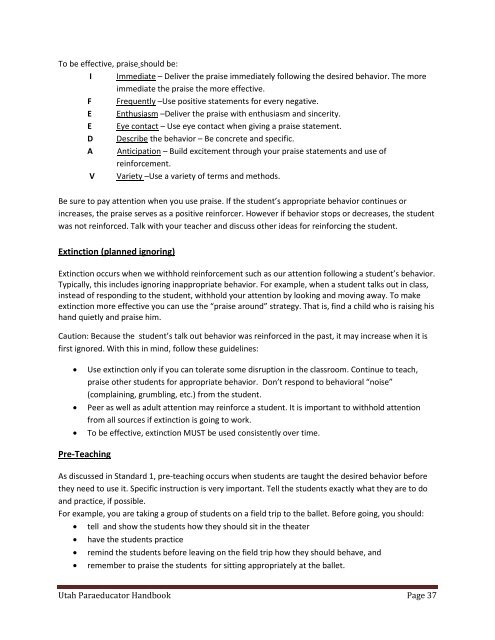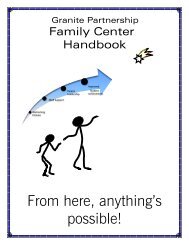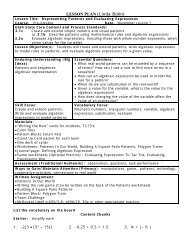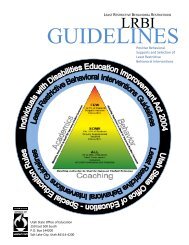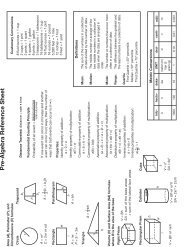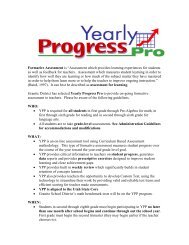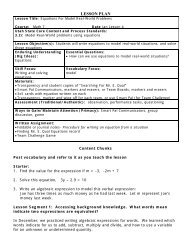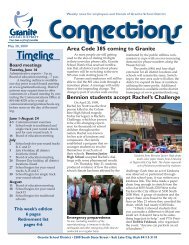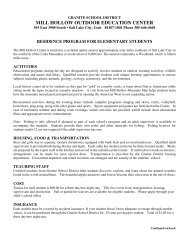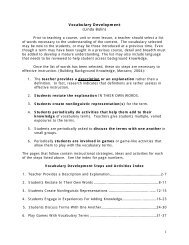Utah Special Education Paraeducator Handbook - Granite School ...
Utah Special Education Paraeducator Handbook - Granite School ...
Utah Special Education Paraeducator Handbook - Granite School ...
Create successful ePaper yourself
Turn your PDF publications into a flip-book with our unique Google optimized e-Paper software.
To be effective, praise should be:<br />
I Immediate – Deliver the praise immediately following the desired behavior. The more<br />
immediate the praise the more effective.<br />
F Frequently –Use positive statements for every negative.<br />
E Enthusiasm –Deliver the praise with enthusiasm and sincerity.<br />
E Eye contact – Use eye contact when giving a praise statement.<br />
D Describe the behavior – Be concrete and specific.<br />
A Anticipation – Build excitement through your praise statements and use of<br />
reinforcement.<br />
V Variety –Use a variety of terms and methods.<br />
Be sure to pay attention when you use praise. If the student’s appropriate behavior continues or<br />
increases, the praise serves as a positive reinforcer. However if behavior stops or decreases, the student<br />
was not reinforced. Talk with your teacher and discuss other ideas for reinforcing the student.<br />
Extinction (planned ignoring)<br />
Extinction occurs when we withhold reinforcement such as our attention following a student’s behavior.<br />
Typically, this includes ignoring inappropriate behavior. For example, when a student talks out in class,<br />
instead of responding to the student, withhold your attention by looking and moving away. To make<br />
extinction more effective you can use the “praise around” strategy. That is, find a child who is raising his<br />
hand quietly and praise him.<br />
Caution: Because the student’s talk out behavior was reinforced in the past, it may increase when it is<br />
first ignored. With this in mind, follow these guidelines:<br />
<br />
<br />
<br />
Use extinction only if you can tolerate some disruption in the classroom. Continue to teach,<br />
praise other students for appropriate behavior. Don’t respond to behavioral “noise”<br />
(complaining, grumbling, etc.) from the student.<br />
Peer as well as adult attention may reinforce a student. It is important to withhold attention<br />
from all sources if extinction is going to work.<br />
To be effective, extinction MUST be used consistently over time.<br />
Pre-Teaching<br />
As discussed in Standard 1, pre-teaching occurs when students are taught the desired behavior before<br />
they need to use it. Specific instruction is very important. Tell the students exactly what they are to do<br />
and practice, if possible.<br />
For example, you are taking a group of students on a field trip to the ballet. Before going, you should:<br />
<br />
<br />
<br />
<br />
tell and show the students how they should sit in the theater<br />
have the students practice<br />
remind the students before leaving on the field trip how they should behave, and<br />
remember to praise the students for sitting appropriately at the ballet.<br />
<strong>Utah</strong> <strong>Paraeducator</strong> <strong>Handbook</strong> Page 37


